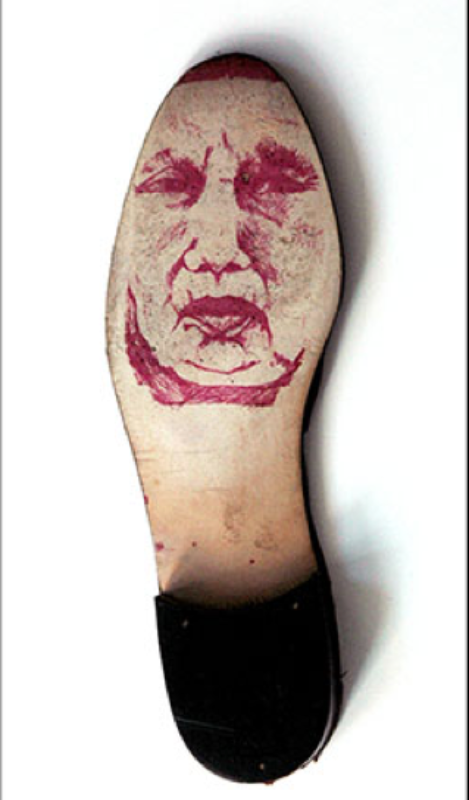Artist Nancer Lemoins' work often deals with the beauty of nature and the rage that comes from seeing injustice. As a long term artist member with Visual AIDS, Lemoins' work has been in numerous web galleries and exhibitions, including her print, "Will Art Save My Life? Will It Bring My Fucking Friends Back" that was part of last years' "Not Over" exhibition at La MaMa Galleria. For the Visual AIDS blog, Lemoins writes about her life, her latest series, " Women On the Shoe" and how you can help her by donating your old shoes to her.
My partner and I moved into a new neighborhood a few years ago. As we got to know people I would tell them I am living with HIV, and one thing I have noticed since then is, people no longer just say “Hi.” They look at me and ask, “How are you feeling?” There is this one young guy who looks at me with such sincerity when he does it, and it really pisses me off. Why can’t he just treat me with the same sense of vitality he would anyone else? I suspect it is mainly because I have AIDS, but also it seems that it is because I am older and I am a woman. I am an older woman. There. I said it.
Similarly, why can a door almost slam in my face, meanwhile some guy will literally fall over himself to hold a door open for a younger woman? Is it because I am seen as an old lady – or not seen because I am an “old lady”— and so people think they don’t have to care?
I talk about this with women living on the street, who will be so happy if I can give them 99 cents for a hamburger, so they can sit in a McDonalds for a few hours and eat. Who sees them? This breaks my heart. This is what happens to women when they age, they get disregarded. And it is worse if you are poor. People don’t think through how women survive. When we age, as when we have AIDS, we can’t always manage to work full time. And what of the women who are just too emotionally battered and broken to work? Flexible jobs that respect that someone might not always have the strength or emotional stamina to work do not exist, which means fewer options, which means less opportunity. And so the less money you have, the worse you get treated. I started thinking; poor women get treated no better than gunk on the bottom of someone’s shoes, so I started making the Women on The Shoe Series.
When I started the project I thought a lot about including men, because it can be just as hard for them if they don’t have money, but in the end I stuck with women because I think it is harder for us overall. There is a different standard and I think that has to do with ideas of beauty, or lost beauty.
I am working to create a world where women don’t need face-lifts to stay young, where their aging is seen as a virtue and their wrinkled faces are seen as a map of wisdom and experiences.
For the project, I start by drawing a woman, usually a combination from real life and found images and quite a bit from my mind. I use my non-dominant hand. It is an exercise in limitation and it has resulted in a gift. It changes how I see the women, how I experience them. It changes how I draw, right down to how I understand a line.
After I am done a drawing I scan it and play around on the computer. If I am making a silkscreen then I will replicate the drawing and add text. The words come from women I talk to, or friends. I am endlessly curious about people.
For the shoes, I scan the drawing at half tone, print it on a transparency, shoot the image to a photosensitized screen and then push the ink through the screen. I work at KALA, a big printmaking studio in Berkeley. Screening the work on the shoes is incredibly hard. I have spent a lot of time and resources on the trial and error period. There is the bend of the shoe I have to think about, and ensuring the heal does not rip the silk. And then there is the fact that this process only works on leather bottom light soled shoes. I tried it on the plastic shoes with the black base shoes, but the paint does not stick. It just does not work. But leather bottom shoes are expensive.
Now, after clearing out all the Bay Area thrift shops, I am looking to friends and strangers to give me the shoes they don’t want – regardless of the quality of the actual shoe. What is important is that the sole is light leather; lots of dirt and even holes are fine. Because the thing is, we can think something is no longer of value, but all it takes is a little effort, and imagination, and we can see the value in everything, and, in everyone.
Thanks to all of you.
To donate your leather bottomed shoes, contact Nancer Lemoins. Accepting donations from New York and the Bay Area and wherever you are.

